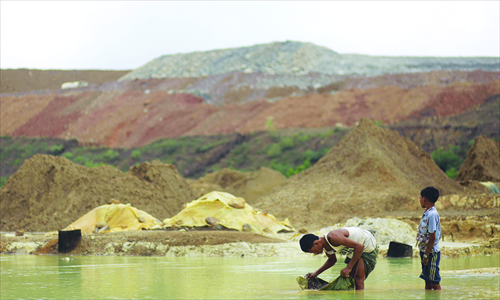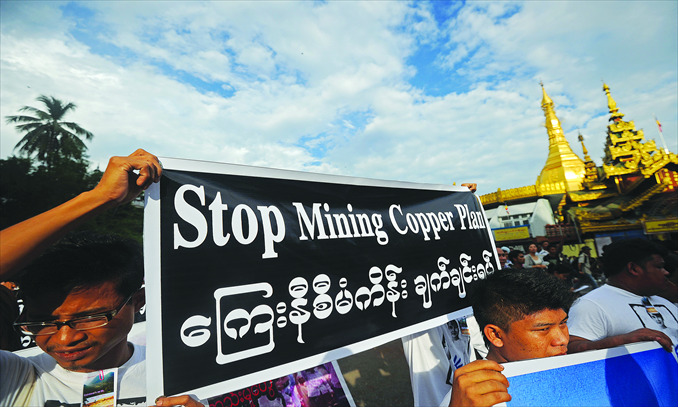Wooing old customers anew

After a bumpy four-hour drive west from Mandalay, Myanmar's second-largest city, we landed at the Letpadaung copper mine of the Monywa copper mining area in the country's northern Sagaing division. As the mine is under construction, the usually noisy work sites were abnormally quiet.
The project, jointly developed by China's State-owned enterprise Wanbao Mining Ltd and its partner, the Union of Myanmar Economic Holdings Ltd (UMEHL), has come under fire over the past few months.
Some local villagers, with the help of activists and some opposition parties, have staged several rounds of protests against the project since June, accusing the mining company of illegally acquiring land and polluting the environment.
With a total investment of $1.07 billion, the joint development of the Letpadaung copper mine by Wanbao and UMEHL was approved by the Myanmar government in 2010. It is scheduled to enter operation in June 2013. However, the protests have disrupted construction plans.
Protests continue to surge
Construction of the Letpadaung mine, an expansion of the Monywa complex, covering an area of 7,877 acres, called for the relocation of 442 households from four villages, stipulating land compensation for residents of 26 villages nearby.
On November 19, another large-scale protest was held against the backdrop of US President Barack Obama's visit to Yangon. According to the local Irrawaddy newspaper, the 1,000 protesters included villagers, students and monks. There were also student activists and protesters holding signs demanding an end to the mine project outside Yangon University, where Obama gave a speech during his visit.
The locals are mainly complaining about inadequate compensation and worrying the project would pollute water, cause health problems and destroy religious heritage, Soe Sandar Oo, a reporter with the Yangon-based Myanmar Times, told the Global Times.
Min Zeya, secretary of the 88 Generation Students Group, which actively helped to organize the protests, told the Global Times that "those villagers who have agreed to move did so mainly out of fear. Those protesters are clamoring against the unfairness linked to the project. There is a great divergence between the villagers and the companies over compensation. They cannot gain reasonable and legal compensation for the confiscated land. There is a non-transparent standard at work here."

According to Deng Hengbo, assistant general manager of Myanmar Wanbao, 218 of 442 households have moved to the new villages built for them so far. The others remain reluctant to move even though nearly all of them have accepted the compensation amounts, Deng told the Global Times.
The company so far has spent $5.7 million in compensation for the crops on the land and it will pay $3,400 in rent a year to the government for each square kilometer. The compensation standard is set based on local laws. There are over 1,700 acres of land privately developed by the villagers which have not been officially registered but Wanbao also compensated them at equal tariffs.
As for environmental concerns, the company says it invited SGS Singapore, a leading inspection, verification, testing and certification service to assess the environmental impact every three months to better control potential ecological problems.
Deng also stressed the project had undergone tests from the Myanmar National Human Rights Commission and a research group from Yangon University. However, these did not defuse public worries.
Political targets
The Letpadaung copper mine project is not the first Chinese investment project to face protests in Myanmar. Last September, Myanmar President Thein Sein ordered the suspension of the construction of Myitsone Hydropower Project in upstream Ayeyawady River, a project backed by China Power Investment, which was sparked by strong public outrage on non-transparent cooperation and environmental risks.
Certain motivations for the protests may not entirely be aboveboard, says Geng Yi, managing director of the Myanmar Wanbao Mining Copper Ltd. "Besides the local villagers, the interference of forces including some opposition organizations have intensified the conflicts. They have taken the project as a stage to win political points," Geng told the Global Times.
Some protesters were alleged to have been wearing opposition parties' uniforms and badges.
A strategist based in Yangon said that as for the latest large-scale protest on November 19, it was possible that some political forces had taken advantage of Obama's Myanmar visit to exert pressure on China.
The 88 Generation Student Group emphasized to the Global Times that its engagement in the protests against Letpadaung project was purely out of concern for the villagers. Meanwhile, Min Zeya added that for many Myanmese citizens, the problem lay in the fact the contract was signed with the military government and was not transparent.
Unclear future
Facing pressure after months of protests, the Myanmar parliament agreed to establish a special group to investigate the project on November 23, the final day of the fifth session of parliament. According to a report by the Myanmar Times, the motion was sponsored by National League for Democracy member Daw Khin San Hlaing, the representative for Pale in the Sagaing Region.
It was reported that "an independent, national-level commission composed of individuals and organizations trusted by the public and local and foreign experts and organizations" would investigate the Letpadaung expansion and then issue public findings and recommendations.
An administrative official from Myanmar Wanbao told the Global Times that they hoped the composition of the group would not include members with anti-China sentiments.
In light of slogans such as "Stop mining copper plan" and "Myanmar Wanbao get out," Geng said, "the company needs time to prove to the Myanmese people the long-term benefits of the project for the government and the locals."
The Letpadaung project will generate 100,000 tons of cathode copper per year. After the project goes into operation, between 1,000 and 1,500 job opportunities will be provided. Those job opportunities will be prioritized for the relocated villagers.
Than Naing, a 40-year-old local worker on the project, told the Global Times he was pleased with the current job with a salary of $230, and is expecting a raise once the project goes into operation. The company is promising to provide more training opportunities.
The company has also set itself lofty community engagement goals. It has contributed a lot to building roads and wells, providing free treatment to local villagers in an established hospital and donated several schools in the area, vowing to continue these efforts in the future. "We are hoping to build a harmonious, mutually beneficial relationship with the local community," Geng said.
A Chinese journalist based in Yangon for many years told the Global Times that the project should be continued in a mutually beneficial way.
But he cautioned that Myanmar Wanbao would need to engage in constant communication with the public, respond quickly to any media questions and doubt and ensure there are no environmental issues.
Tough time for Chinese firms
"This is the toughest time for Chinese investment in Myanmar," Jin Honggen, economic and commercial counselor with the Chinese embassy in Myanmar, told the Global Times. Some projects are mired in controversy and since the Myitsone dam issue, no new investments from China have come in, Jin added.
According to official statistics, China remains the biggest investor in the country with a total investment of over $14.1 billion, but hostility against Chinese investments is on the rise.
"Some Chinese companies in Myanmar, especially those investing in resource fields, are worrying their interests can't be secured," Jin said.
Although the figures remain guesswork, Geng said that the disruption to the construction by protests had caused them great losses.
Min Zeya said that for many Myanmese citizens, China and Chinese companies are on the side of the government, not of the people. Many people feel that the government has sold out to China in order to keep money flowing into the coffers and Chinese companies in Myanmar are only exploring their own interests.
"Those are misperceptions," Jin refuted. For this, he blames China's poor publicity campaigns in Myanmar.
China has assisted the Myanmar government in building several factories and infrastructure such as roads, bridges and theaters. Its companies have built schools, hospitals and roads for locals and donated to disaster relief funds. However, these have not been well communicated to the public.
"Foreign investment in mining, oil, and gas is always controversial, because of the perception that precious resources are being exploited by outsiders. Since there are many Chinese investments in Myanmar, naturally there will be many protests," Michael Kugelman, South and Southeast Asia associate at the Woodrow Wilson International Center for Scholars based in Washington DC, told the Global Times.
"It is important to improve firms' capacities to anticipate possible sources of opposition, whether real or perceived. Firms will need to be more transparent about the terms in their contracts, and will need to be very clear on important issues such as compensation and employment," Kugelman said.